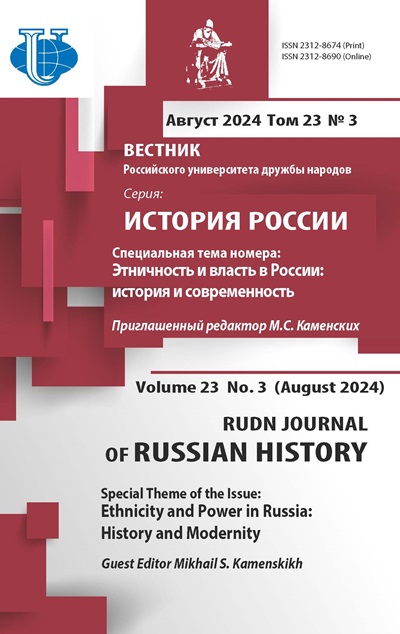C оветская таджикская писательская элита в конце 1930-х годов
- Авторы: Сии Н.1
-
Учреждения:
- Университет штата Огайо
- Выпуск: Том 19, № 1 (2020): Жизнь наций СССР в 1920−1950-е гг.
- Страницы: 119-135
- Раздел: ЖИЗНЬ НАЦИЙ СССР В 1920−1950Е ГГ.
- URL: https://journals.rudn.ru/russian-history/article/view/22988
- DOI: https://doi.org/10.22363/2312-8674-2020-19-1-119-135
Цитировать
Полный текст
Аннотация
Статья посвящена истории формирования новой таджикской советской литературной элиты в 1930-е гг. На примере реализации проекта «Политика советских национальностей» показан процесс становления новых национальных символов, языка, мифологии Таджикистана, представлены основные его участники в лице основателей таджикской литературы - Садриддина Айни и Аболкосима Лахути и молодых авторов - Мирзо Турсунзаде, Ялола Икроми, Сотима Улугзода и др., которые стали ключевыми фигурами в культурной и политической жизни республики в послевоенную эпоху. Показано, что роль таджикского писателя в те годы во многом определялась необходимостью создания и изображения национального субъекта в контексте советского развития. Проведенный автором анализ тематики художественных произведений двух поколений литераторов 1930-х гг. продемонстрировал то, как построение национальной идентичности таджиков, определение их территориальной локализации были связаны с национальной политикой Советского Союза той эпохи. Данная статья опирается на разные группы источников, включая документы Центрального государственного архива Республики Таджикистан и онлайн-архивов, публицистические материалы и художественные произведения. Автор приходит к выводу, что мобилизация молодого поколения представителей таджикской советской литературной интеллигенции привела к формированию нового типа таджикской национальной идентичности на советском пространстве. В отличие от Садриддина Айни и Аболкосима Лахути, молодые таджикские литераторы сумели вписаться в условия советской действительности. Именно они формировали с конца 1930-х гг. новую таджикскую идентичность, став в итоге лидерами художественной литературы Центральной Азии в послевоенный период советской истории.
Об авторах
Николас Сии
Университет штата Огайо
Автор, ответственный за переписку.
Email: seay.27@buckeyemail.osu.edu
аспирант кафедры истории
43210, США, шт. Огайо, г. Колумбус, Энни энд Джон Глен Авеню, 203Список литературы
- Abudullaev, K. Historical Dictionary of Tajikistan. Lanham: Rowman & Littlefi eld, 2018.
- Becka, J. Sadriddin Ayni: Father of Modern Tajik Culture. Naples: Istituto Universitario orientale: Seminario Di Studi Asiatici: Series Minor V, 1980.
- Clark, K. The Soviet Novel: History as Ritual. Bloomington: Indiana University Press, 2000.
- Grassi, E. “From Bukhara to Dushanbe: Outlining the Evolution of Soviet Tajik Fiction,” Iranian Studies 50, no. 5 (2017): 680-705.
- Hodgkin, S. “Classical Persian Canons of the Revolutionary Press, Abū al-Qāsim Lāhūtī’s Circles in Istanbul and Moscow.” In A. Mozafari, H. Rezaei Yazdi, Persian Literature and Modernity: Production and Reception, 185-212. London: Routeledge, 2018.
- Holt, K. “Performing as Central Asia’s Source Texts: Lahuti and Dzambul in Moscow, 1935-1936.” Cahiers d’Asie centrale, no. 24 (2015): 213-238.
- Holt, K. “The Rise of Insider Iconography: Visions of Soviet Turkmenia in Russian-Language Literature and Film, 1921-1935.” PhD diss., Columbia University, 2013.
- Khalid, A. Making Uzbekistan: Nation, Empire, and Revolution in the Early USSR. Ithaca: Cornell University Press, 2015.
- Lapin, B., and Khatsrevin, Z. “Abul’ Gasem Lakhuti.” Pravda (September 4, 1935) (in Russian).
- Lakhuti, A. Izbrannaia lirika. Stalinobod: Gosudarstvennoye izdatel’stvo tadzhikskoy SSR Publ., 1940 (in Russian).
- Martin, T. Affi rmative Action Empire: Nations and Nationalism in the Soviet Union, 1929-1939. Ithaca: Cornell University Press, 2011.
- Mirskiy, D. “Vokrug Tadzhikskoy Literatury.” Pravda (August 20, 1935) (in Russian).
- Osmanova, Z. Ocherk istorii tadzhikskoy sovetskoy literatury. Moscow: Akademiya Nauk Publ., 1961 (in Russian).
- Roberts, F. “Old Elites Under Communism: Soviet rule in Leninobod.” The University of Chicago, 2016.
- Schild, K. “Between Moscow and Baku: National Literatures at the 1934 Congress of Soviet Writers.” PhD diss., University of California, Berkley, 2010.
- Shaw, Ch. “Making Ivan-Uzbek: War, Friendship of the Peoples, and the Creation of Soviet Uzbekistan, 1941-1945.” PhD diss., University of California, Berkley, 2015.
- Tursun-zade, M. “Protiv Kosmopolitizma i Paniranizma.” Literaturanaya Gazeta (February 9, 1949) (in Russian).
- Yountchi, L. “Between Russia and Iran: Soviet Tajik Literature and Identity, 1920-1991.” PhD diss., Northwestern University, 2011.
- Yountchi, L. “The Politics of Scholarship and the Scholarship of Politics: Imperia, Soviet, and postSoviet Scholars Studying Tajikistan.” In The Heritage of Soviet Oriental Studies, 225-226. New York: Routledge, 2011
Дополнительные файлы
















